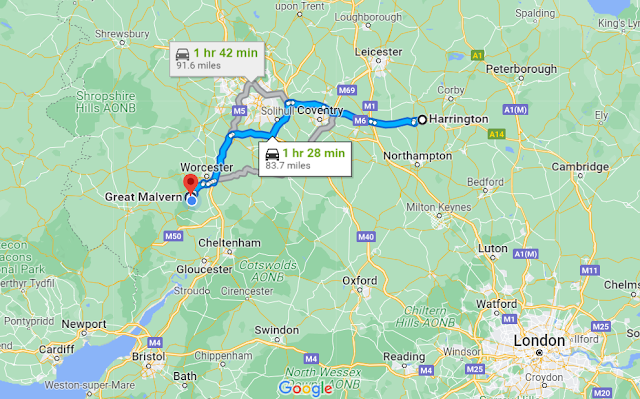...or this little blue tit. Awwwwww!!!!!
And sparrows that stay in the UK actually increase the weight of their down by 70% as they prepare for the British winter. It's a bit like us people putting on extra layers of clothing, isn't it, when it comes to it. Go on, admit it, you do that sometimes as well, don't you!
However, there's more to it than that. In 2021, scientists at Lund University Sweden discovered that these non-migratory birds also use their blood to actually generate heat inside the birds' little fluffy bodies.
Do you understand the above diagram? I didn't really either. But I think that the thing on the left is a red blood cell, and the little sausage-shaped yellow things inside it are what are called mitochondria.
Who knew that birds apparently, unlike humans, have busy little mitochondria living within their red blood cells? These are the powerhouse of their cells, receiving the sugar that comes in, plus the oxygen, and then through the process of respiration, turning these into energy for the body.
The surprising thing, however, is that these levels of mitochondria aren't the same all year round. When the scientists first looked at the red blood cells of tits, for example, they counted the number of mitochondria present, and measured their activity levels. But when they later counted them again in winter, they found that the number of mitochondria had increased, and, not only that, that they were working even harder than during the earlier study.
See? Simples isn't it! That's why these plucky little round-the-year birds don't need to buy heavy winter jackets in Primark. It's all beginning to make sense now, isn't it!
Lois and I have never studied the red blood cells in tits, but we did visit Lund in the cold winter days of December 2016. Yes, we visited Lund, Sweden, where these discoveries were made, in the company of our daughter Alison, her husband Ed, and their 3 children.
[Can I just point out that that isn't relevant to the present discussion?! - Ed]
[No, sorry, there isn't time for you to make that point right now, I'm afraid! Later, perhaps! - Colin]
Happy days!
[Can I just point out...? - Ed]
[No sorry, this blog is just closing for today, I'm afraid! Sorry! - Colin]
Anyway, the pictures are relevant, because they demonstrate that if you're in Lund in winter, you need to put on several layers of clothing - unless you're a tit of course haha!
22:00 We go to sleep - zzzzzzzz!!!!!
Friday January 27th 2023
We complete the journey back home to Malvern in the morning.
20:30 In the evening we wind down with today's edition of Winterwatch.
Lois and I went through a lot of trauma a couple of months back, when, after 36 years, we moved out of our house in Cheltenham and made a downsizing move to Malvern.
Our troubles, however, are nothing as compared to those of hermit crabs. Who knew that hermit crabs don't grow their own shells? Yes, it's true! They have to find one lying around and live in that one, and every so often, when they've outgrown their shell, they have to "upsize" to a new one, either by locating one that's just lying around or by taking one off another hermit crab, possibly risking a vicious fight in the process.
What madness!!!!
(nb fault in subtitles: for "presidents" read "predators")
And what about those cute little woodlice? Who knew that they use to be aquatic, millions of years ago? They're crustaceans, and they need a lot of water, it seems.
And who knew that many species of woodlice have evolved a way of sucking in water up through their anuses, where they keep a little sponge - no, not one bought from Dunelm, it's one that they grow on their own bodies, the cunning little tykes! And it's vital for them to do this: if they dry out, they die.
And female woodlice make wonderful mums. Just before breeding they grow a pouch on her body, on her underbelly. It's called a marsupium and it's the woodlouse equivalent of the pouches that kangaroos and other marsupials use to carry their young about.
She stashes all her eggs away in that fluid-filled pouch, her marsupium. It's full of water and a mix of other stuff.
close-up of a typical woodlouse's marsupium:
and you can see all the little eggs stuffed away inside,
each one a future little woodlouse - awwwwww!!!!
A visual aid shows, in magnified form, the underside of a female woodlouse, and if you peel off the cover of the marsupium (Don't try this at home!), you see all the cute little woodlice that have been hatching.
Awwwww !!!!!
And those little baby woodlice don't just scuttle away. Their mum keeps them in the marsupium for about a month, floating about, with everything in there that they need to survive, all the nutrients they need etc. And their mum can monitor and regulate the acidity of the babies' environment, as they exhaust their poor mum's fat reserves. Eventually they fully hatch out and wander off into the woodlands, as happy little woodlice.
Would you like to adopt one? They're very well-trained. They don't urinate, they just emit ammonia, so as long as you don't mind the smell, they won't ruin your carpets, which is nice!
What a crazy world it is, though, the world of woodlice!!!
21:30 We go to bed on the puzzles in the back-pages of next week's Radio Times. We have high hopes of the Popmaster this week, but score a disappointing 2 out of 10, which is annoying. Damn!
We do pick up 7 out of 10 on the Eggheads questions, however, which is some compensation. Basically we're both exhausted from our travels this week, so we think 7 out of 10 isn't bad.
22:00 Zzzzzzzzz!!!!!!





























No comments:
Post a Comment